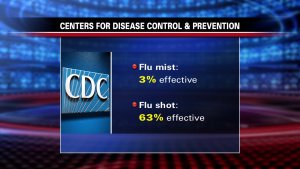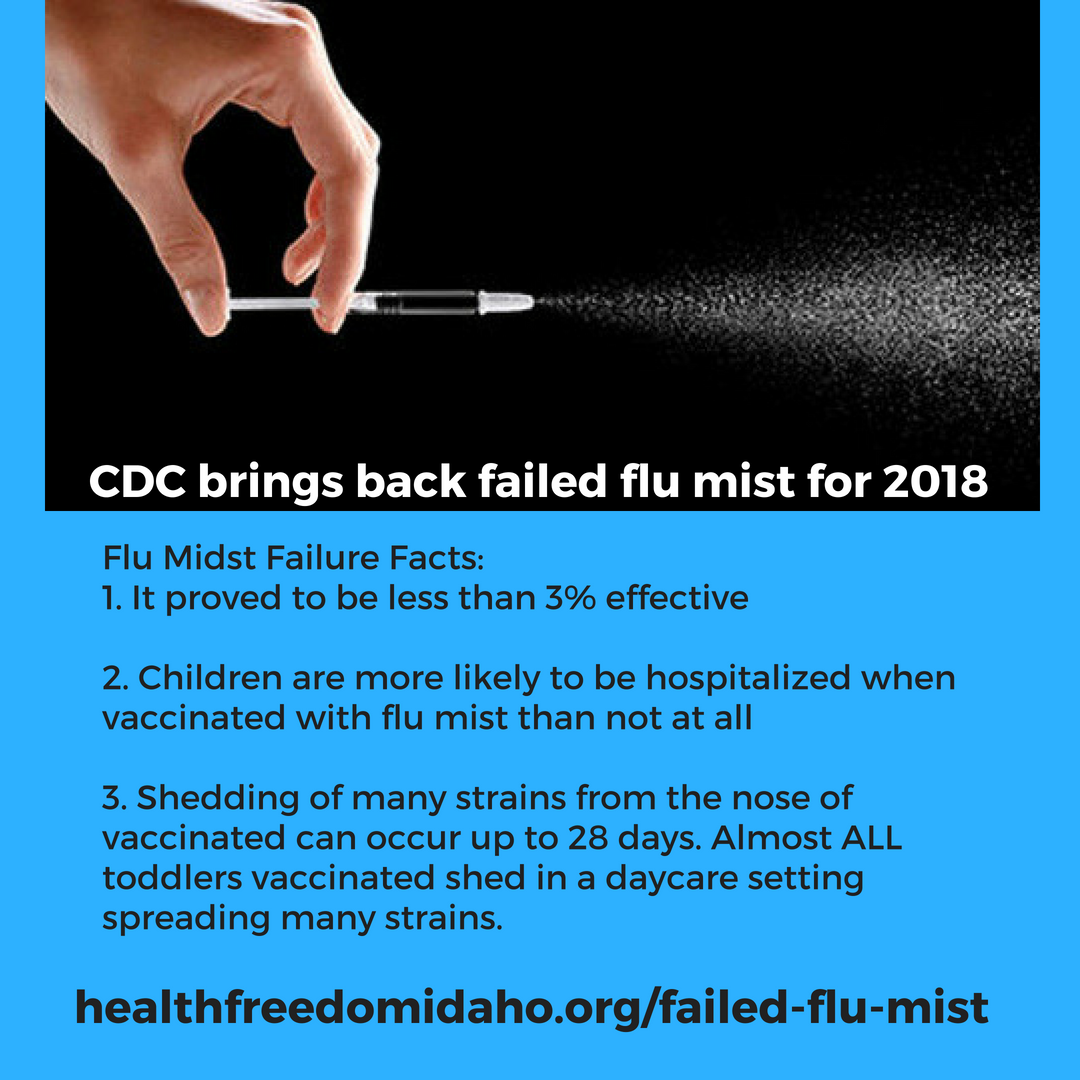Failed Flu Mist Vaccine Returns for 2018


Breaking News expect outbreaks of the flu this season. The CDC has brought back the (LIVE VIRUS) FluMist nasal spray. It was initially pulled due to poor “efficacy” boasting a 3% protection rating, which can more than likely be blamed on viral shedding from said vaccine. Most package inserts of live viral vaccines (MMR, chickenpox, shingles, flumist, rabies) state shedding can last for 2-5 weeks post vaccination. And if remembered correctly, last year it was noted by a study performed by PNAS, paid for by the CDC, that even those vaccinated with IM/injectable flu vaccinations had an increased shedding rate 6.3x more than those who do not receive a flu vaccination. Also, per Science Daily, it should also be noted that children who receive the flu vaccine have 3x the risk of hospitalization for Flu.
Why on earth would you want to spray live virus into your nostrils. Think about it! They stopped giving it because it wasn’t working! Now suddenly it’s going to work? I guess it will work at spreading the Flu…
Late last year Health Impact News reported on a study published by The Scripps Research Institute in La Jolla, California, documenting how influenza viruses cultured in eggs mutate, making the flu vaccines virtually worthless.
The authors of the study stated:
Seasonal influenza vaccine does not always confer protection in vaccinated individuals. Vaccine candidates are selected from clinical isolates based on their antigenic properties.
It is common to use chicken eggs for culturing clinical isolates and for large-scale production of vaccines. However, influenza virus often mutates to adapt to being grown in chicken eggs, which can influence antigenicity and hence vaccine effectiveness.

See:
Study: Annual Flu Shot Ineffective
Is the U.S. Mass Flu Vaccination Program Actually Causing More Severe Influenza Outbreaks?
Over the past few years, several studies have pointed to the fact that repeated flu vaccinations year after year actually reduces the effectiveness of the vaccine, raising serious questions about yearly mass flu vaccination programs.
The most recent was a study out of Australia where researchers showed that those who had multiple flu vaccines actually produced fewer antibodies than those who did not get the flu shot regularly.
Most people probably do not realize that the measure of success for a vaccine is not whether you stay healthy or get sick, but simply if your body develops the appropriate antibodies thought to be required to fight off the disease being vaccinated against.
Dr. Sherri Tenpenny explains this very well in the following video:
This was not the first study to show that repeated flu shots every year decrease one’s resistance to influenza viruses.
Dr. Edward Belongia of the Wisconsin’s Marshfield Clinic Research Foundation reported the same thing back in 2015, and a study in 2013 showed that getting the flu shot two years in a row lowered protection.
We have frequently published an interview with Dr. Mark Geier explaining how little science there is behind the flu vaccine.
Dr. Geier is NOT anti-vaccine. He is an M.D. and has a Ph.D. in genetics. He spent 10 years working at the National Institute of Health, and was a professor at Johns Hopkins University as a geneticist. He is also the author of over 150 peer-reviewed publications.
He worked on vaccine safety and efficacy for more than 30 years. He was one of four scientists that worked to replace the DTP vaccine, a vaccine that caused every child to become sick with a high fever at the time of vaccination, with the DTaP vaccine, which is a more purified vaccine.
Dr. Geier explains that the CDC does not follow the law for vaccines in requiring long-term safety testing for the influenza vaccine like they do with other vaccines, as it is impossible to test a vaccine that changes every year.
So the flu vaccine is basically an experimental vaccine that they want to give out to 300 million people every year. There are also no studies showing the safety of giving the flu vaccine to the same person every single year.
However, Dr. Geier points out that the CDC is in the business of distributing ‘flu vaccines, because they represent 300 million doses per year, whereas all the childhood vaccines together only number 20 million.
Dr. Geier explains that flu is “the wrong thing to vaccinate against” because you have to keep re-vaccinating against it every year, unlike childhood infectious diseases, such as smallpox, that are only vaccinated for once.
Learn How to Boost Your Natural Immunity
Sources:
https://www.cdc.gov/media/releases/2016/s0622-laiv-flu.html
Something to think about and consider when (not if) flu epidemics begin to rise in our country this year. Who is really responsible for the “outbreaks?”
Shedding: Vaccine Insert 12.2 Pharmacodynamics Shedding Studies
Shedding of vaccine viruses within 28 days of vaccination with FluMist was evaluated in (1) multi-center
study MI-CP129 which enrolled healthy individuals 6 through 59 months of age (N = 200); and (2) multi-
center study FM026 which enrolled healthy individuals 5 through 49 years of age (N = 344). In each study,
nasal secretions were obtained daily for the first 7 days and every other day through either Day 25 and on
Day 28 or through Day 28. In study MI-CP129, individuals with a positive shedding sample at Day 25 or
Day 28 were to have additional shedding samples collected every 7 days until culture negative on
2 consecutive samples. Results of these studies are presented in Table 5.
Return of FluMist: http://www.cidrap.umn.edu/news-perspective/2018/02/cdc-vaccine-panel-brings-back-flumist-2018-19-season
http://www.pnas.org/content/early/2018/01/17/1716561115
https://www.thewilddoc.com/cdc-funded-study-shows-the-vaccinated-shed-6-3-times-more-flu-virus-just-by-breathing/
https://www.sciencedaily.com/releases/2009/05/090519172045.htm






